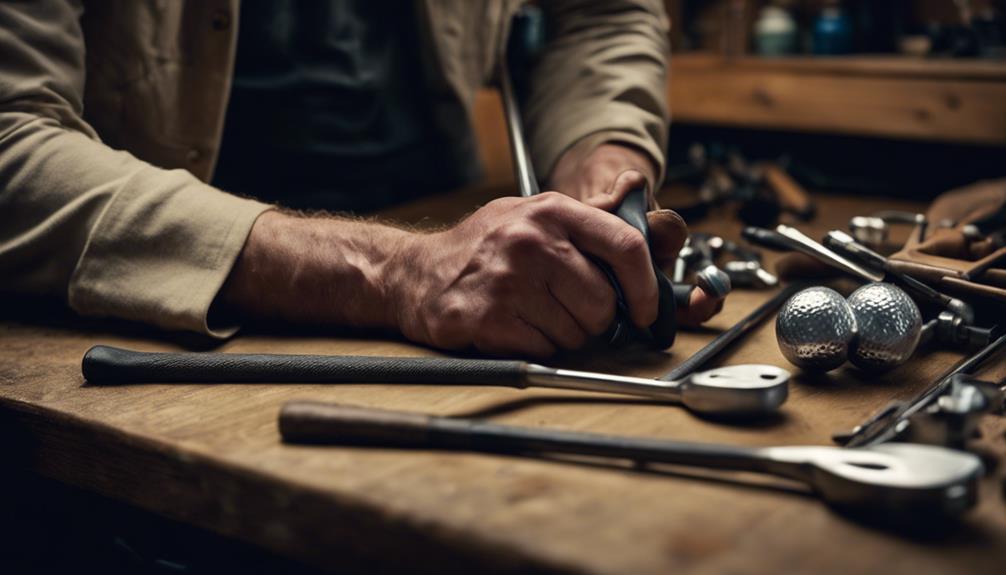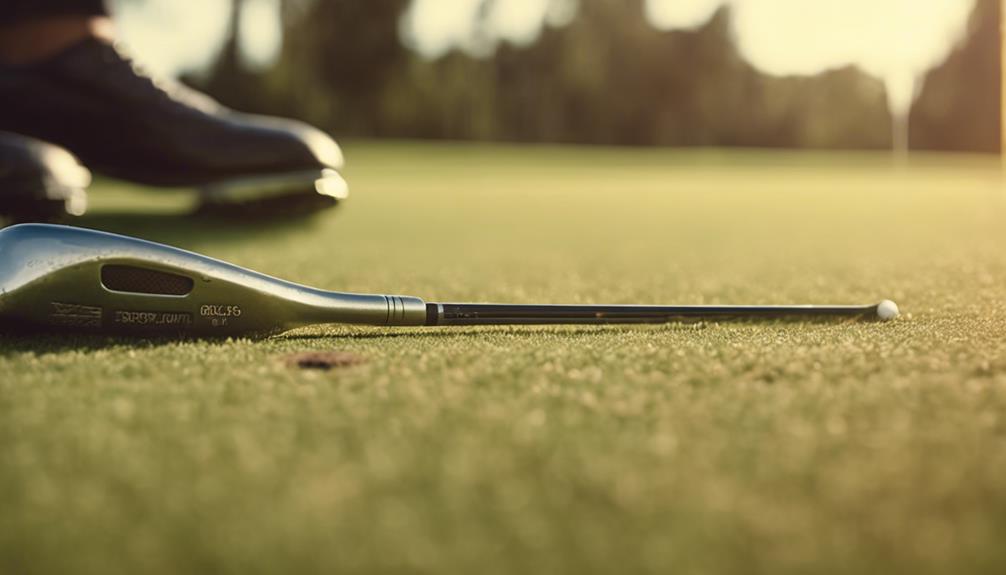- 7 Top Flite Golf Clubs XL for Improved Performance - September 28, 2024
- Top Flite Golf Clubs: Top 5 Reasons to Choose Them - September 28, 2024
- Top 3 Golf Club Fitters for a Perfect Swing - September 28, 2024
You're ready to extend your golf clubs in 7 easy steps. First, determine your desired length extension based on your physical characteristics, swing style, and comfort. Gather necessary tools and materials, including a golf shaft cutter and epoxy. Remove the clubhead, prepare the shaft, and apply epoxy to attach the extension. Align and secure the extension properly, then reattach the clubhead and check the swing weight. Make final adjustments and test your extended club on the driving range. With these steps, you'll be on your way to optimizing your swing and game performance – and that's just the starting point for releasing your full potential.
Key Takeaways
- Measure your current club length considering physical characteristics, swing style, and comfort to determine the desired extension length.
- Gather necessary tools and materials, including a golf shaft cutter, hacksaw, and epoxy, to ensure accurate and secure extension installation.
- Remove the clubhead, prepare the shaft by cleaning and measuring, and install the ferrule to ensure a strong bond with the extension.
- Apply epoxy to the extension and shaft, align them properly, and allow the epoxy to cure to secure the extension in place.
- Reattach the clubhead, check the swing weight, and make final adjustments to ensure a balanced and well-performing extended golf club.
Determine Desired Length Extension
In order to ascertain the ideal length extension for your golf clubs, begin by measuring the current length of your clubs, taking into consideration your unique physical characteristics, swing style, and overall comfort on the course. This will provide you with a baseline to work from, enabling you to determine how much longer you wish your clubs to be.
Reflect on your height, posture, and swing characteristics when selecting the extension length – do you require a bit more length to compensate for a shorter stature, or do you aim to uphold a more upright posture? A typical extension length is 1/2 inch, but some golfers may prefer a longer extension to enhance their overall performance. It's crucial to contemplate your individual needs and preferences when identifying the desired length extension.
If you're uncertain, seek guidance from a professional club fitter who can offer expert advice on the suitable extension length for your clubs. Keep in mind, the objective is to discover an extension length that enhances your comfort and performance on the course, so invest the time and effort to make an informed decision.
Gather Necessary Tools and Materials
Now that you've determined the desired length extension, it's time to gather the necessary tools and materials to get the job done.
You'll need to select the right tools, such as a shaft cutter and shaft extractor, to guarantee a precise extension process.
Next, you'll choose the appropriate materials, including extension ferrules and epoxy, and prepare your shafts for the extension process.
Tool Selection
You'll need to gather a specific set of tools and materials before extending your golf clubs, starting with a golf shaft cutter for steel shafts or a hacksaw with a grit edge blade for graphite shafts. This is essential, as using the wrong tool can damage your shafts.
When working with graphite shafts, don't forget to have some masking tape on hand to prevent splintering when cutting. Next, you'll need a ferrule installation tool, which makes installing ferrules on extended shafts a breeze. You'll also need some epoxy for adhesion when installing those ferrules.
Finally, have some sandpaper ready to prep your steel shaft tips and graphite shafts before extending them. Having these tools and materials at your disposal will guarantee a smooth and successful extension process. Remember, using the right tools is key to achieving professional-looking results.
Take the time to gather everything you need, and you'll be well on your way to extending your golf clubs like a pro.
Material Choices
When it comes to extending your golf clubs, selecting the right materials is essential, as it directly impacts the overall performance and appearance of your clubs.
You'll need a range of materials to guarantee a successful extension process. First, you'll require a Shaft Extender, which allows you to lengthen steel shafts to your desired size.
Additionally, you'll need epoxy to securely bond the extension to the shaft. Ferrules are also necessary for providing a professional finish and preventing the shaft from splitting.
When working with graphite shafts, don't forget to use masking tape to prevent splintering during the cutting process. You'll also need sandpaper to prep the shafts for extension and a golf shaft cutter for trimming the shafts to the correct length.
With these materials in hand, you'll be well on your way to extending your golf clubs like a pro. Remember, using the right materials is essential for achieving the best results, so don't skimp on quality.
Shaft Preparation
With your materials in hand, gather the necessary tools, including a golf shaft cutter or hacksaw frame, to guarantee an accurate and clean cut that sets the stage for a successful shaft preparation process. Having all the tools and materials ready will help you avoid interruptions and maintain focus on the task at hand.
Proper shaft preparation is vital for extending your golf club effectively and ensuring a secure fit for the extension. You'll need:
- A ferrule installation tool to secure the ferrule to the shaft
- Masking tape to shield the shaft from epoxy
- Sandpaper (100 grit for steel shafts, 150 grit for graphite shafts) to even out the cut
- Epoxy and lead tape for added stability and weight distribution
Using the correct tools, such as a golf shaft cutter for steel shafts and a hacksaw frame with a grit edge blade for graphite shafts, will help you achieve neat and precise cuts.
Remove Clubhead and Prepare Shaft

Now that you've successfully removed the clubhead, it's time to focus on preparing the shaft for extension. You'll need to take precise measurements to guarantee a seamless process.
You'll want to follow a few essential tips to get the ferrule installation just right.
Next, you'll learn the shaft prep essentials that guarantee a secure bond and a successful extension.
Shaft Measurement Tips
You'll want to accurately mark the shaft with a pen or tape measure to determine the hosel depth, a critical measurement that sets the stage for a successful club extension. This precise measurement will guarantee a proper fit and prevent any issues down the line.
When measuring, keep in mind that iron shafts require special attention due to their unique characteristics.
Here are some essential shaft measurement tips to keep in mind:
- Measure the shaft butt to determine the correct extension length
- Record the shaft's outer diameter to secure the ferrule fits properly
- Mark the shaft's tip to guide your cutting process
- Double-check your measurements to avoid any errors
Ferrule Installation Guide
Having accurately measured your shaft, remove the clubhead to prepare the shaft for ferrule installation, ensuring a secure bond between the two components. This step is essential, as a strong shaft-clubhead connection is vital for peak performance.
Use a clubhead removal tool to carefully detach the clubhead from the shaft, taking care not to damage the shaft or the clubhead. Once removed, inspect the shaft for any debris or residue, and clean it thoroughly with a shaft cleaning solution.
Next, prepare the shaft for ferrule installation by lightly sanding the area where the ferrule will be attached. This will guarantee a strong bond between the shaft and the ferrule. Make sure the shaft is dry and free of any oils or residue, as this can impact the adhesive properties of the ferrule.
With the shaft prepared, you're ready to move on to the next step in the ferrule installation process. A well-installed ferrule not only enhances the club's appearance but also safeguards the shaft-clubhead connection, giving you confidence in your game.
Shaft Prep Essentials
Remove the clubhead from the shaft by applying heat to break down the epoxy bond, taking care to avoid damaging the components. This is an important step in the shaft preparation process, ensuring a secure bond between the shaft and the new extension.
To guarantee a successful extension process, follow these necessary shaft prep steps:
- Clean the old epoxy residue from the shaft's tip by sanding it with the appropriate grit sandpaper (100 grit for steel shafts, 150 grit for graphite shafts).
- Confirm the shaft tip is smooth and free of debris to maintain a secure bond.
- Carefully measure and mark the desired length for the extension on the shaft to ensure proper fit and alignment.
- Verify that the shaft is properly prepared to prevent any issues during the extension process.
Proper shaft preparation is essential to the success of extending your golf clubs and maintaining the integrity of the club's structure. By following these steps, you'll be well on your way to a successful extension process.
Apply Epoxy and Attach Extension
With the extension and shaft thoroughly cleaned and prepared, apply a thin, even layer of epoxy to the inside of the extension and the tip of the shaft. This will guarantee a secure bond between the two components.
| Step | Description |
|---|---|
| 1 | Apply epoxy to extension and shaft |
| 2 | Slide extension onto shaft, guaranteeing alignment |
| 3 | Clean off excess epoxy |
| 4 | Allow epoxy to cure according to manufacturer's instructions |
| 5 | Inspect and test the extended club |
When attaching the extension, be mindful of the swing weight change. A half-inch extension can make a significant difference in your swing dynamics. Take your time to make sure the extension is properly aligned and seated.
Once the epoxy has fully cured, your extended club is ready for use on the course. Remember to inspect the connection regularly to confirm it remains secure and functional. With the extension properly attached, you're one step closer to achieving the perfect swing.
Align and Secure Extension Properly

You must make certain the extension is precisely aligned with the shaft, as any misalignment can compromise the club's integrity and affect its performance.
Proper alignment is essential to maintain the club's balance and feel during swings.
To align and secure the extension properly, follow these steps:
- Use epoxy or adhesive specifically designed for golf club repairs to secure the extension in place effectively.
- Ensure the extension is aligned with the shaft correctly to maintain the club's integrity.
- Follow manufacturer guidelines for aligning and securing the extension to ensure peak club performance.
- Double-check the alignment and secure attachment of the extension to prevent club breakage during play.
Reattach Clubhead and Check Swing Weight
After extending the shaft, reattach the clubhead by applying a small amount of epoxy to the connection point, establishing a secure bond that can withstand the rigors of play. This step is vital to prevent any issues during play and maintain durability.
Once the clubhead is securely attached, it's crucial to check the swing weight to uphold the club's balance and feel. You can adjust the swing weight by adding weight to the head or grip to counterbalance the changes from extending the shaft. This adjustment is significant, as it directly impacts your shots' consistency and overall performance. According to Club Reviews, a well-balanced club can make all the difference in your game.
Make Final Adjustments and Test

Having confirmed the clubhead's secure attachment and ideal swing weight, it's essential to make final adjustments and test the extended club to make sure it meets your specifications and performs as anticipated. You've put in the effort to extend your clubs, and now it's time to fine-tune the results.
To achieve peak performance, follow these steps:
- Check the final length of the extended club to guarantee it matches your specifications.
- Make any necessary adjustments to the grip and clubhead to complete the extension process.
- Test the extended club on the driving range to evaluate how the changes impact your swing and ball flight.
- Pay attention to how the club feels and performs after the extension to determine if further adjustments are needed.
During testing, pay attention to how the clubs used actually felt in your hands. Did the extension affect the overall balance and feel of the club? Make note of any changes and adjust accordingly.
If necessary, seek feedback from a professional club fitter or instructor to fine-tune the extended club for peak performance. By following these final steps, you'll be able to enjoy your extended golf clubs and take your game to the next level.
Frequently Asked Questions
How Do I Lengthen My Golf Clubs?
You'll need a professional club fitter to lengthen your golf clubs, involving shaft modifications and grip replacement or customization to guarantee a precise fit, maintaining ideal swing weight and club feel.
How to Arrange Golf Clubs in a 7 Divider Bag?
As you're getting ready for a round, you're probably thinking, "I've got my clubs, now what?" Arrange them in your 7-divider bag by type, ensuring bag organization and club protection, while also considering weight distribution for carrying comfort.
How Do You Size Golf Clubs for Your Height?
You size golf clubs for your height by using a club fitting chart or consulting a professional for customization, ensuring a precise height adjustment that matches your equipment fitting, resulting in optimized performance.
When Should I Extend My Golf Clubs?
When you're struggling to connect, consider extending your golf clubs if club fitting reveals a mismatch, as this tweak can bring numerous benefits, including improved posture and reduced back strain, with custom shafts offering flexible options.
Conclusion
You've successfully extended your golf clubs, unleashing a new level of power and precision in your game. Your hard work has paid off, and now you're ready to take on the course with confidence.
As you step up to the tee, feel the added length and control in your swing, and let your game shine.
With your newly extended clubs, you're poised to crush your opponents and make unforgettable shots that'll leave them green with envy.




